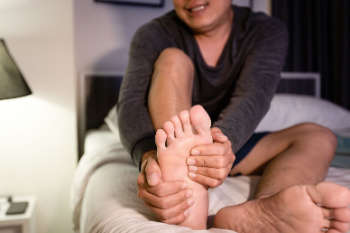Items filtered by date: September 2024
Bunion Surgery Procedures

Bunion surgery is designed to alleviate pain and correct the misalignment caused by bunions. The procedure may involve several techniques depending on the severity and specific characteristics of the bunion. Exostectomy is the removal of the bony bump, while osteotomy realigns the bones of the toe to correct its position. Arthrodesis, or fusion surgery, involves joining two bones in the toe to stabilize the joint and reduce pain. Resection arthroplasty removes the damaged joint and reshapes the bones to improve function. Post-surgery, you can expect a recovery period involving rest, wearing special footwear, and gradual rehabilitation exercises. If you have a bunion that is causing discomfort, it is suggested that you consult a podiatrist who can determine if surgery is right for you.
Foot surgery is sometimes necessary to treat a foot ailment. To learn more, contact Patrick Bruton, DPM of Big Country foot and Ankle. Our doctor will assist you with all of your foot and ankle needs.
When Is Surgery Necessary?
Foot and ankle surgery is generally reserved for cases in which less invasive, conservative procedures have failed to alleviate the problem. Some of the cases in which surgery may be necessary include:
- Removing foot deformities like bunions and bone spurs
- Severe arthritis that has caused bone issues
- Cosmetic reconstruction
What Types of Surgery Are There?
The type of surgery you receive will depend on the nature of the problem you have. Some of the possible surgeries include:
- Bunionectomy for painful bunions
- Surgical fusion for realignment of bones
- Neuropathy decompression surgery to treat nerve damage
Benefits of Surgery
Although surgery is usually a last resort, it can provide more complete pain relief compared to non-surgical methods and may allow you to finally resume full activity.
Surgical techniques have also become increasingly sophisticated. Techniques like endoscopic surgery allow for smaller incisions and faster recovery times.
If you have any questions please feel free to contact our offices located in Abilene, and Brownwood, TX . We offer the newest diagnostic and treatment technologies for all your foot and ankle needs.
Plantar Fasciitis Relief

Plantar fasciitis is a common foot condition that causes pain in the heel and the bottom of the foot. It occurs when the plantar fascia, a thick band of tissue that runs along the bottom of your foot and connects the heel bone to the toes, becomes inflamed. This inflammation is often due to overuse, excessive pressure, or improper footwear. People with plantar fasciitis typically experience sharp, stabbing pain, especially in the morning or after long periods of rest. To manage plantar fasciitis, it is important to rest and avoid activities that can worsen the pain. Wearing supportive shoes can help to reduce strain. In more severe cases, corticosteroid injections, or even surgery may be necessary to achieve relief. If you have plantar fasciitis, it is strongly suggested that you schedule an appointment with a podiatrist for treatment.
Plantar fasciitis can be very painful and inconvenient. If you are experiencing heel pain or symptoms of plantar fasciitis, contact Patrick Bruton, DPM from Big Country foot and Ankle. Our doctor can provide the care you need to keep you pain-free and on your feet.
What Is Plantar Fasciitis?
Plantar fasciitis is the inflammation of the thick band of tissue that runs along the bottom of your foot, known as the plantar fascia, and causes mild to severe heel pain.
What Causes Plantar Fasciitis?
- Excessive running
- Non-supportive shoes
- Overpronation
- Repeated stretching and tearing of the plantar fascia
How Can It Be Treated?
- Conservative measures – anti-inflammatories, ice packs, stretching exercises, physical therapy, orthotic devices
- Shockwave therapy – sound waves are sent to the affected area to facilitate healing and are usually used for chronic cases of plantar fasciitis
- Surgery – usually only used as a last resort when all else fails. The plantar fascia can be surgically detached from the heel
While very treatable, plantar fasciitis is definitely not something that should be ignored. Especially in severe cases, speaking to your doctor right away is highly recommended to avoid complications and severe heel pain. Your podiatrist can work with you to provide the appropriate treatment options tailored to your condition.
If you have any questions please feel free to contact our offices located in Abilene, and Brownwood, TX . We offer the newest diagnostic and treatment technologies for all your foot and ankle needs.
Foot Injuries From Pickleball on the Rise

As pickleball continues to rise in popularity, so does the incidence of foot injuries among players. This fast-paced sport, which combines elements of tennis, badminton, and ping-pong, involves quick lateral movements, sudden pivots, and constant pressure on the feet, making them vulnerable to various injuries. Common foot injuries in pickleball include plantar fasciitis, Achilles tendonitis, and stress fractures. These injuries are often the result of inadequate footwear, overuse, or insufficient warm-up and stretching before play. Players may also experience ankle sprains from sudden changes in direction, a frequent occurrence in the game. Preventing foot injuries in pickleball starts with wearing proper court shoes that offer good support and cushioning. Regular stretching exercises, particularly focusing on the calves and Achilles tendon, can also help. Additionally, gradually increasing play intensity and taking rest days can reduce the risk of overuse injuries. If you enjoy pickleball but have incurred a foot injury, it is suggested that you schedule an appointment with a podiatrist for a proper diagnosis and treatment.
Sports related foot and ankle injuries require proper treatment before players can go back to their regular routines. For more information, contact Patrick Bruton, DPM of Big Country foot and Ankle. Our doctor can provide the care you need to keep you pain-free and on your feet.
Sports Related Foot and Ankle Injuries
Foot and ankle injuries are a common occurrence when it comes to athletes of any sport. While many athletes dismiss the initial aches and pains, the truth is that ignoring potential foot and ankle injuries can lead to serious problems. As athletes continue to place pressure and strain the area further, a mild injury can turn into something as serious as a rupture and may lead to a permanent disability. There are many factors that contribute to sports related foot and ankle injuries, which include failure to warm up properly, not providing support or wearing bad footwear. Common injuries and conditions athletes face, including:
- Plantar Fasciitis
- Plantar Fasciosis
- Achilles Tendinitis
- Achilles Tendon Rupture
- Ankle Sprains
Sports related injuries are commonly treated using the RICE method. This includes rest, applying ice to the injured area, compression and elevating the ankle. More serious sprains and injuries may require surgery, which could include arthroscopic and reconstructive surgery. Rehabilitation and therapy may also be required in order to get any recovering athlete to become fully functional again. Any unusual aches and pains an athlete sustains must be evaluated by a licensed, reputable medical professional.
If you have any questions please feel free to contact our offices located in Abilene, and Brownwood, TX . We offer the newest diagnostic and treatment technologies for all your foot and ankle needs.
Causes of Flexible Flat Feet

Flat feet, or pes planus, occur when the arches of the feet do not develop properly or collapse over time, resulting in the entire sole touching the ground when standing. This condition is common and often begins in childhood, with flexible flat feet being the most prevalent type. In this form, the arch appears only when the foot is lifted and disappears when it touches the ground. While many individuals experience no pain, flat feet can often cause discomfort during prolonged standing, walking, or running. Additional causes can include a tight Achilles tendons and posterior tibial tendon dysfunction, which may lead to pain and instability in the foot and ankle. Factors like genetics, aging, injury, obesity, and certain medical conditions increase the risk of developing flat feet. A podiatrist can evaluate your foot structure, recommend orthotic supports, and suggest treatments to alleviate pain. If you often experience foot problems related to flat feet, it is suggested that you schedule an appointment with a podiatrist for an exam and treatment options.
Flatfoot is a condition many people suffer from. If you have flat feet, contact Patrick Bruton, DPM from Big Country foot and Ankle. Our doctor will treat your foot and ankle needs.
What Are Flat Feet?
Flatfoot is a condition in which the arch of the foot is depressed and the sole of the foot is almost completely in contact with the ground. About 20-30% of the population generally has flat feet because their arches never formed during growth.
Conditions & Problems:
Having flat feet makes it difficult to run or walk because of the stress placed on the ankles.
Alignment – The general alignment of your legs can be disrupted, because the ankles move inward which can cause major discomfort.
Knees – If you have complications with your knees, flat feet can be a contributor to arthritis in that area.
Symptoms
- Pain around the heel or arch area
- Trouble standing on the tip toe
- Swelling around the inside of the ankle
- Flat look to one or both feet
- Having your shoes feel uneven when worn
Treatment
If you are experiencing pain and stress on the foot you may weaken the posterior tibial tendon, which runs around the inside of the ankle.
If you have any questions please feel free to contact our offices located in Abilene, and Brownwood, TX . We offer the newest diagnostic and treatment technologies for all your foot and ankle needs.

